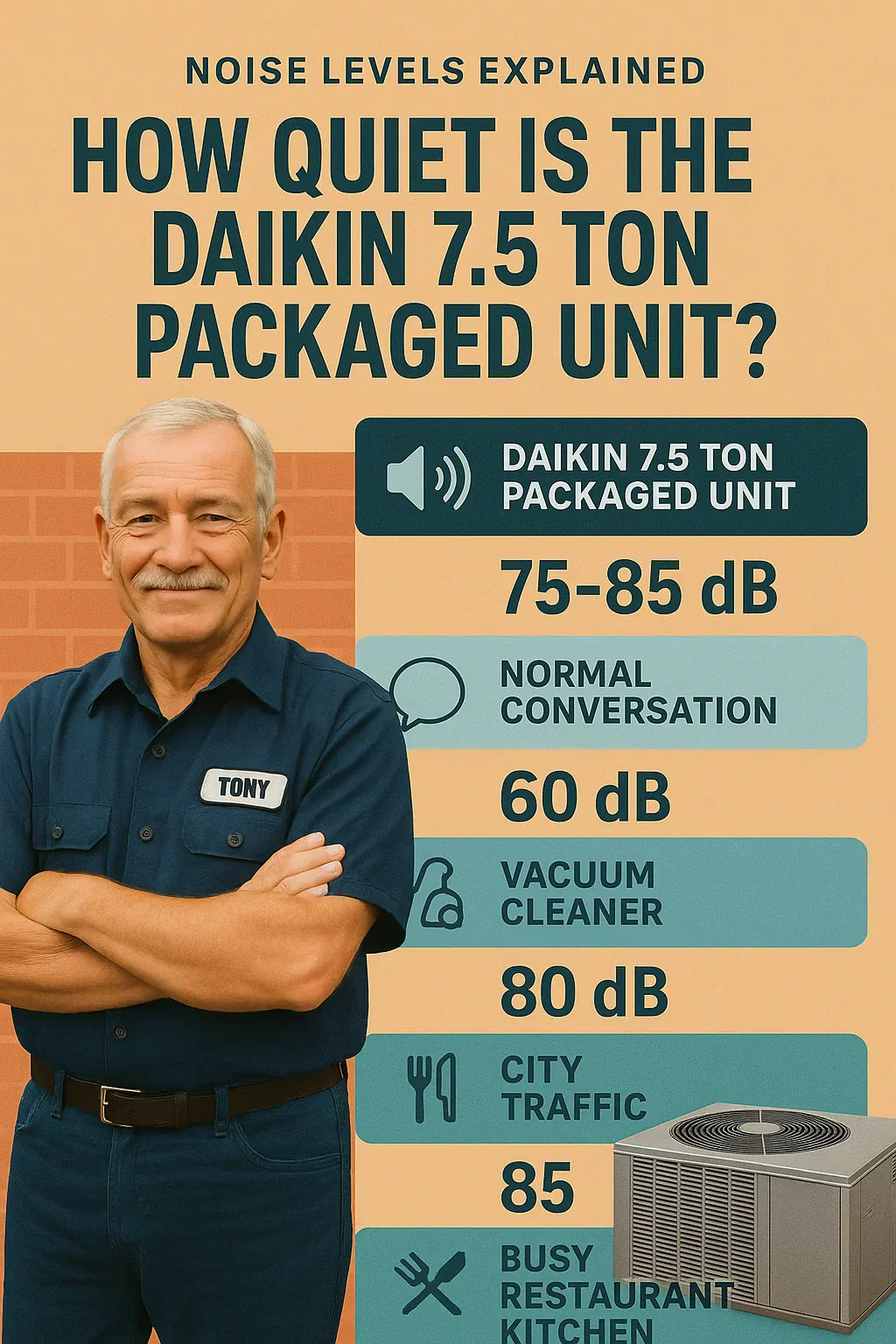When you’re shopping for a 7.5 ton packaged AC and gas furnace system like the Daikin Light Commercial 7.5 Ton Packaged Unit (Model DFG0904DM00001S), you’ll see a lot of numbers about efficiency (IEER2, SEER2). But there’s one number many business owners overlook: decibels.
Noise matters. Too loud, and your employees complain. Customers notice. Even neighboring businesses might raise a fuss. So how quiet is the Daikin 7.5 ton packaged system really? Let’s break it down Tony-style — clear, practical, and with comparisons you’ll recognize.
📏 What Are HVAC Noise Ratings?
HVAC systems are rated in decibels (dB), a logarithmic scale used to measure sound.
Here’s the important part:
-
+10 dB sounds twice as loud to the human ear.
-
A 75 dB unit isn’t just “a little louder” than 65 dB — it feels about twice as loud.
Noise is usually reported as:
-
Sound Power Level (LwA): How much sound energy the unit produces.
-
Sound Pressure Level (LpA): How loud it feels at a certain distance (e.g., 3 feet, 10 feet).
📌 ASHRAE provides guidelines on acceptable sound levels in commercial spaces.
👉 Tony’s analogy: Think of sound power as how strong a speaker is, and sound pressure as how loud it feels when you’re standing next to it.
📉 Typical Noise Levels for Packaged Units
Most 7.5 ton packaged rooftop or ground units produce noise in the range of 75–85 dB at 3 feet.
-
Daikin’s 7.5 ton packaged unit: designed with sound-dampening cabinets, insulated compressors, and optimized fan blades to reduce noise.
-
Competitors (Carrier, Trane, Lennox) fall in similar ranges.
👉 Translation: At close range, you’ll hear it. But from inside the building, especially with rooftop placement, it blends into background noise.
📌 Carrier Commercial Rooftop Units and Trane Light Commercial Systems publish sound performance ranges confirming this standard.
🏢 Real-World Comparisons: How Loud Is 75–85 dB?
Here’s how HVAC packaged unit noise stacks up against everyday sounds:
-
60 dB = normal conversation
-
70 dB = vacuum cleaner
-
75 dB = busy office or street traffic
-
80 dB = blender or heavy traffic
-
85 dB = restaurant kitchen or diesel truck idling
👉 That means a packaged rooftop unit is about as loud as street traffic if you’re standing right next to it.
📌 NIOSH (CDC) provides noise level charts used in workplace safety.
🛠️ Factors That Affect Real-World Noise
Not every 7.5 ton system will sound the same once installed. Noise depends on:
📍 1. Installation Location
-
Rooftop units: Noise is mostly outside, with only a faint hum indoors.
-
Ground-level units: Louder indoors if placed near windows or walls that reflect sound.
🧱 2. Building Acoustics
-
Concrete walls bounce sound.
-
Open windows or glass storefronts let it in.
🔧 3. Vibration & Isolation
-
Without vibration pads, units can cause rattling sounds inside.
-
Proper curb mounting or isolation pads = quieter operation.
🧹 4. Maintenance Condition
-
Dirty fan blades or loose components = louder operation.
-
Worn belts can squeal.
-
Neglected units get louder over time.
📌 Energy Star’s commercial HVAC guide highlights maintenance as key to keeping units running efficiently and quietly.
🤫 Noise Control Strategies
If noise is a concern, there are practical ways to cut it down.
-
Vibration isolators: Rubber or spring mounts reduce building-borne sound.
-
Acoustic barriers: Rooftop screens or fencing redirect sound away from neighbors.
-
Smart placement: Keep units away from offices, classrooms, or customer patios.
-
Regular maintenance: Clean coils, tighten hardware, replace worn parts.
📌 ASHRAE’s Acoustics Handbook gives engineering solutions for commercial HVAC sound.
👉 Tony’s tip: “Spend a couple hundred bucks on vibration pads now, and you’ll save yourself years of employee complaints.”
📊 Case Studies: Noise in Action
🛍️ Retail Store (4,800 sq. ft.)
-
Rooftop Daikin 7.5 ton system.
-
Noise inside: barely noticeable — background hum.
-
Outdoor noise: ~78 dB next to unit, blends with traffic.
🍽️ Restaurant (3,500 sq. ft., ground-level install)
-
Unit installed behind building near windows.
-
Employees noticed noise during peak dinner hours.
-
Fix: Added acoustic screen + vibration pads → noise dropped by ~8 dB.
🏥 Medical Office (4,200 sq. ft.)
-
Rooftop install with proper isolation.
-
Patients reported no noise complaints.
-
Consistent comfort without distraction.
✅ Tony’s Take: Should You Worry About Noise?
Here’s my straight answer:
-
Rooftop installs: Noise is a non-issue indoors.
-
Ground installs: Plan carefully. Use barriers, vibration pads, or smart placement.
-
Older vs. new systems: New Daikin units are quieter than legacy equipment thanks to design improvements.
👉 Bottom line: A 7.5 ton Daikin packaged unit runs quiet enough for offices, stores, and restaurants — as long as it’s installed right.
📌 Final Word from Tony
Noise levels shouldn’t scare you off a 7.5 ton packaged unit. At 75–85 dB outdoors, a Daikin system is about as loud as city traffic — noticeable if you’re standing next to it, but hardly a distraction once installed properly.
The real trick isn’t the unit — it’s the installation. Put it on the roof, add vibration pads, and keep it maintained. Do that, and your employees, customers, and neighbors won’t even notice it’s running.
In the next topic we will know more about: Maintenance Guide: How Tony Keeps His Daikin 7.5 Ton Packaged AC/Gas Furnace Running Smooth







